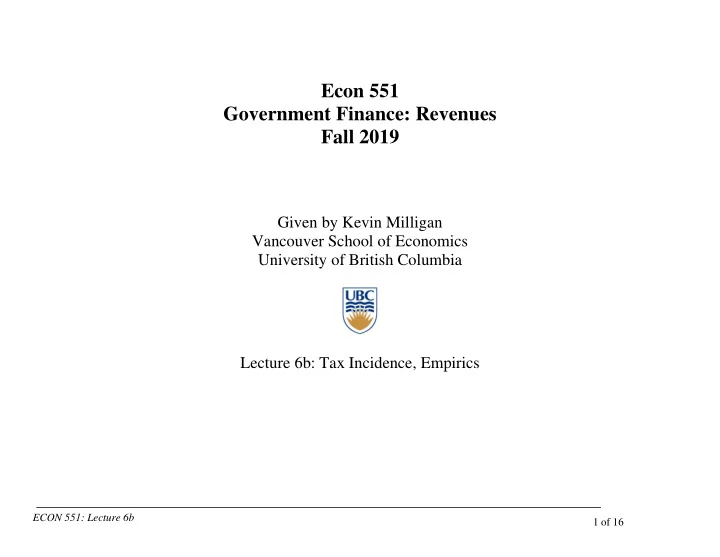

Econ 551 Government Finance: Revenues Fall 2019 Given by Kevin Milligan Vancouver School of Economics University of British Columbia Lecture 6b: Tax Incidence, Empirics ECON 551: Lecture 6b 1 of 16
Agenda: We will go over some recent empirical contributions to get a sense of the state of the empirical literature: What questions are they asking? What models are they testing? ECON 551: Lecture 6b 2 of 16
Why might tax incidence vary from ‘textbook’ predictions? ECON 551: Lecture 6b 3 of 16
Why might tax incidence vary from ‘textbook’ predictions? Imperfect competition: Weyland and Fabinger JPE 2013, Carbonnier 2007 Salience: Chetty/Looney/Kroft AER 2009. Finkelstein QJE2009, Feldman/Ruffle AEJ 2015 Rigidities / adjustment costs: Bargaining power: Besley/Meads/Surico JPubE 2014 Dynamics / Search frictions: Sallee AEJ 2011 Evasion / administration: Kopczuk et al 2016 ECON 551: Lecture 6b 4 of 16
Kopczuk Marion Muehlegger Slemrod (2016 AEJ-Policy) “ Does Tax -Collection Invariance Hold? Evasion and the Pass-Through of State Diesel Taxes ” http://dx.doi.org/10.1257/pol.20140271 Does ‘statutory tax invariance’ hold? Does pass-through depend whether the tax is collected by wholesalers or retailers? Study the case of diesel taxes. ECON 551: Lecture 6b 5 of 16
Diesel taxation States impose fuel taxes that differ in rate and where it is collected (e,g, retail vs wholesale). Varies 8 to 35 cents / gallon across states. Over time state fuel taxes have moved ‘up’ the supply chain; further from consumers. ECON 551: Lecture 6b 6 of 16
Diesel taxation ECON 551: Lecture 6b 7 of 16
Diesel taxation: differential evasion How could you evade diesel taxation? Mis-report intended use. o Highway, home heating, industry, agriculture untaxed. o Dyed fuel for agriculture…. Mis-reporting tax collected. o Distributor doesn’t remit tax that is collected o Distributor conducts a series of transactions to obfuscate. Bootlegging o Get a lower rate for diesel intended for export; then sell within-state. o Apportioned taxes for truckers; misreport miles driven. o Exploit native American reservations. Question: For tax authorities, who is easier to monitor? ECON 551: Lecture 6b 8 of 16
ECON 551: Lecture 6b 9 of 16
Notes on results… First column says that a penny increase in tax leads to a 0.086 drop in tax exclusive price. So, 92.4% of tax increase is passed through to consumers; firms bear little burden. Big pass through! 2 nd column says that prices are higher when tax collected from supplier or distributor rather than retail. Largely significant. 3 rd column says pass-through is higher when tax is levied higher up the supply chain. Robustness checks: Degree of competition. Other input cost pass through. ECON 551: Lecture 6b 10 of 16
Tax administration Example 2: ‘Hidden’ vs ‘Shown’ Sales Tax “Salience and Taxation: Theory and Evidence” Raj Chetty, Adam Looney, and Kory Kroft American Economic Review , Vol. 99, No. 4, pp. 1145-1177. Paper studies the impact of perception on taxation and decision making. Question: Does tax inclusive pricing matter? Tax exclusive pricing: price tags show the pre-tax price. Tax inclusive pricing: price tags show the after-tax price. ECON 551: Lecture 6b 11 of 16
The Experiment In a typical grocery store, they conduct the following experiment: Take the product categories of cosmetics, hair care accessories, and deodorants For two weeks, post special price tags with inclusive pricing. Compare to other product categories. Compare to a previous 6 weeks. Compare to another store with no experiment. Also did a survey of customers: About 80% know the tax rate of 7.375% Customers quite knowledgeable about what is taxed and what is not. ECON 551: Lecture 6b 12 of 16
Price Tag Changes: Hairbrushes ECON 551: Lecture 6b 13 of 16
The Impact: Sales Down! Difference in Difference: 2.14/25.17 = 8.5% down. ECON 551: Lecture 6b 14 of 16
Explanations for sales drop Unaware of taxes? Survey they provided suggests people are aware. ‘Rational’ inattention? Maybe time / psychic effort is costly and it isn’t worth the cost to worry abou the calculations. How could we test this hypothesis? Psychology: cues Brain is distracted by other cues (shape, colour, marketing) and we are distracted from price calculations. How could we test this hypothesis? ECON 551: Lecture 6b 15 of 16
Next Class: … ECON 551: Lecture 6b 16 of 16
Recommend
More recommend